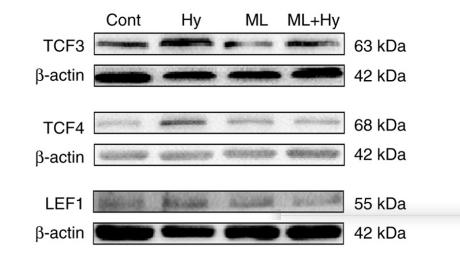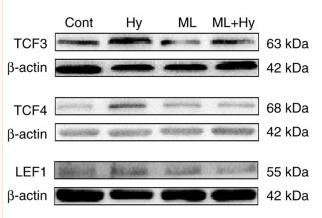TCF7L2 Antibody - #DF7622
| Product: | TCF7L2 Antibody |
| Catalog: | DF7622 |
| Description: | Rabbit polyclonal antibody to TCF7L2 |
| Application: | WB |
| Cited expt.: | WB |
| Reactivity: | Human, Mouse, Rat, Monkey |
| Prediction: | Pig, Zebrafish, Horse, Sheep, Xenopus |
| Mol.Wt.: | 68 kDa, 50 kDa; 68kD(Calculated). |
| Uniprot: | Q9NQB0 |
| RRID: | AB_2841109 |
Related Downloads
Protocols
Product Info
*The optimal dilutions should be determined by the end user. For optimal experimental results, antibody reuse is not recommended.
*Tips:
WB: For western blot detection of denatured protein samples. IHC: For immunohistochemical detection of paraffin sections (IHC-p) or frozen sections (IHC-f) of tissue samples. IF/ICC: For immunofluorescence detection of cell samples. ELISA(peptide): For ELISA detection of antigenic peptide.
Cite Format: Affinity Biosciences Cat# DF7622, RRID:AB_2841109.
Fold/Unfold
HMG box transcription factor 4; hTCF 4; hTCF-4; T cell factor 4; T cell specific HMG box; T cell specific transcription factor 4; T-cell factor 4; T-cell-specific transcription factor 4; TCF 4; TCF-4; TCF4; TCF7L2; TCF7L2 protein; TF7L2_HUMAN; Transcription factor 7 like 2; Transcription factor 7 like 2 T cell specific HMG box; Transcription factor 7-like 2;
Immunogens
A synthesized peptide derived from human TCF7L2, corresponding to a region within the internal amino acids.
Detected in epithelium from small intestine, with the highest expression at the top of the crypts and a gradient of expression from crypt to villus. Detected in colon epithelium and colon cancer, and in epithelium from mammary gland and carcinomas derived therefrom.
- Q9NQB0 TF7L2_HUMAN:
- Protein BLAST With
- NCBI/
- ExPASy/
- Uniprot
MPQLNGGGGDDLGANDELISFKDEGEQEEKSSENSSAERDLADVKSSLVNESETNQNSSSDSEAERRPPPRSESFRDKSRESLEEAAKRQDGGLFKGPPYPGYPFIMIPDLTSPYLPNGSLSPTARTLHFQSGSTHYSAYKTIEHQIAVQYLQMKWPLLDVQAGSLQSRQALKDARSPSPAHIVSNKVPVVQHPHHVHPLTPLITYSNEHFTPGNPPPHLPADVDPKTGIPRPPHPPDISPYYPLSPGTVGQIPHPLGWLVPQQGQPVYPITTGGFRHPYPTALTVNASMSRFPPHMVPPHHTLHTTGIPHPAIVTPTVKQESSQSDVGSLHSSKHQDSKKEEEKKKPHIKKPLNAFMLYMKEMRAKVVAECTLKESAAINQILGRRWHALSREEQAKYYELARKERQLHMQLYPGWSARDNYGKKKKRKRDKQPGETNEHSECFLNPCLSLPPITDLSAPKKCRARFGLDQQNNWCGPCRRKKKCVRYIQGEGSCLSPPSSDGSLLDSPPPSPNLLGSPPRDAKSQTEQTQPLSLSLKPDPLAHLSMMPPPPALLLAEATHKASALCPNGALDLPPAALQPAAPSSSIAQPSTSSLHSHSSLAGTQPQPLSLVTKSLE
Predictions
Score>80(red) has high confidence and is suggested to be used for WB detection. *The prediction model is mainly based on the alignment of immunogen sequences, the results are for reference only, not as the basis of quality assurance.
High(score>80) Medium(80>score>50) Low(score<50) No confidence
Research Backgrounds
Participates in the Wnt signaling pathway and modulates MYC expression by binding to its promoter in a sequence-specific manner. Acts as repressor in the absence of CTNNB1, and as activator in its presence. Activates transcription from promoters with several copies of the Tcf motif 5'-CCTTTGATC-3' in the presence of CTNNB1. TLE1, TLE2, TLE3 and TLE4 repress transactivation mediated by TCF7L2/TCF4 and CTNNB1. Expression of dominant-negative mutants results in cell-cycle arrest in G1. Necessary for the maintenance of the epithelial stem-cell compartment of the small intestine.
In vitro, phosphorylated by TNIK.
Phosphorylated at Thr-201 and/or Thr-212 by NLK. Phosphorylation by NLK at these sites inhibits DNA-binding by TCF7L2/TCF4, thereby preventing transcriptional activation of target genes of the canonical Wnt/beta-catenin signaling pathway.
Polysumoylated. Sumoylation is enhanced by PIAS family members and desumoylation is enhanced by SENP2. Sumoylation/desumoylation regulates TCF7L2/TCF4 transcription activity in the Wnt/beta-catenin signaling pathway without altering interaction with CTNNB1 nor binding to DNA.
Nucleus>PML body.
Note: Diffuse pattern. Colocalizes with SUMO1 and PIAS4 in a subset of PML (promyelocytic leukemia) nuclear bodies.
Detected in epithelium from small intestine, with the highest expression at the top of the crypts and a gradient of expression from crypt to villus. Detected in colon epithelium and colon cancer, and in epithelium from mammary gland and carcinomas derived therefrom.
The promoter-specific activation domain interacts with the transcriptional coactivator EP300.
Belongs to the TCF/LEF family.
Research Fields
· Cellular Processes > Cellular community - eukaryotes > Adherens junction. (View pathway)
· Environmental Information Processing > Signal transduction > Wnt signaling pathway. (View pathway)
· Environmental Information Processing > Signal transduction > Hippo signaling pathway. (View pathway)
· Human Diseases > Infectious diseases: Viral > Human papillomavirus infection.
· Human Diseases > Cancers: Overview > Pathways in cancer. (View pathway)
· Human Diseases > Cancers: Specific types > Colorectal cancer. (View pathway)
· Human Diseases > Cancers: Specific types > Endometrial cancer. (View pathway)
· Human Diseases > Cancers: Specific types > Prostate cancer. (View pathway)
· Human Diseases > Cancers: Specific types > Thyroid cancer. (View pathway)
· Human Diseases > Cancers: Specific types > Basal cell carcinoma. (View pathway)
· Human Diseases > Cancers: Specific types > Acute myeloid leukemia. (View pathway)
· Human Diseases > Cancers: Specific types > Breast cancer. (View pathway)
· Human Diseases > Cancers: Specific types > Hepatocellular carcinoma. (View pathway)
· Human Diseases > Cancers: Specific types > Gastric cancer. (View pathway)
· Human Diseases > Cardiovascular diseases > Arrhythmogenic right ventricular cardiomyopathy (ARVC).
· Organismal Systems > Endocrine system > Melanogenesis.
References
Application: WB Species: rat Sample: atria
Application: WB Species: rat Sample: atria
Application: WB Species: Rat Sample: atria
Restrictive clause
Affinity Biosciences tests all products strictly. Citations are provided as a resource for additional applications that have not been validated by Affinity Biosciences. Please choose the appropriate format for each application and consult Materials and Methods sections for additional details about the use of any product in these publications.
For Research Use Only.
Not for use in diagnostic or therapeutic procedures. Not for resale. Not for distribution without written consent. Affinity Biosciences will not be held responsible for patent infringement or other violations that may occur with the use of our products. Affinity Biosciences, Affinity Biosciences Logo and all other trademarks are the property of Affinity Biosciences LTD.



